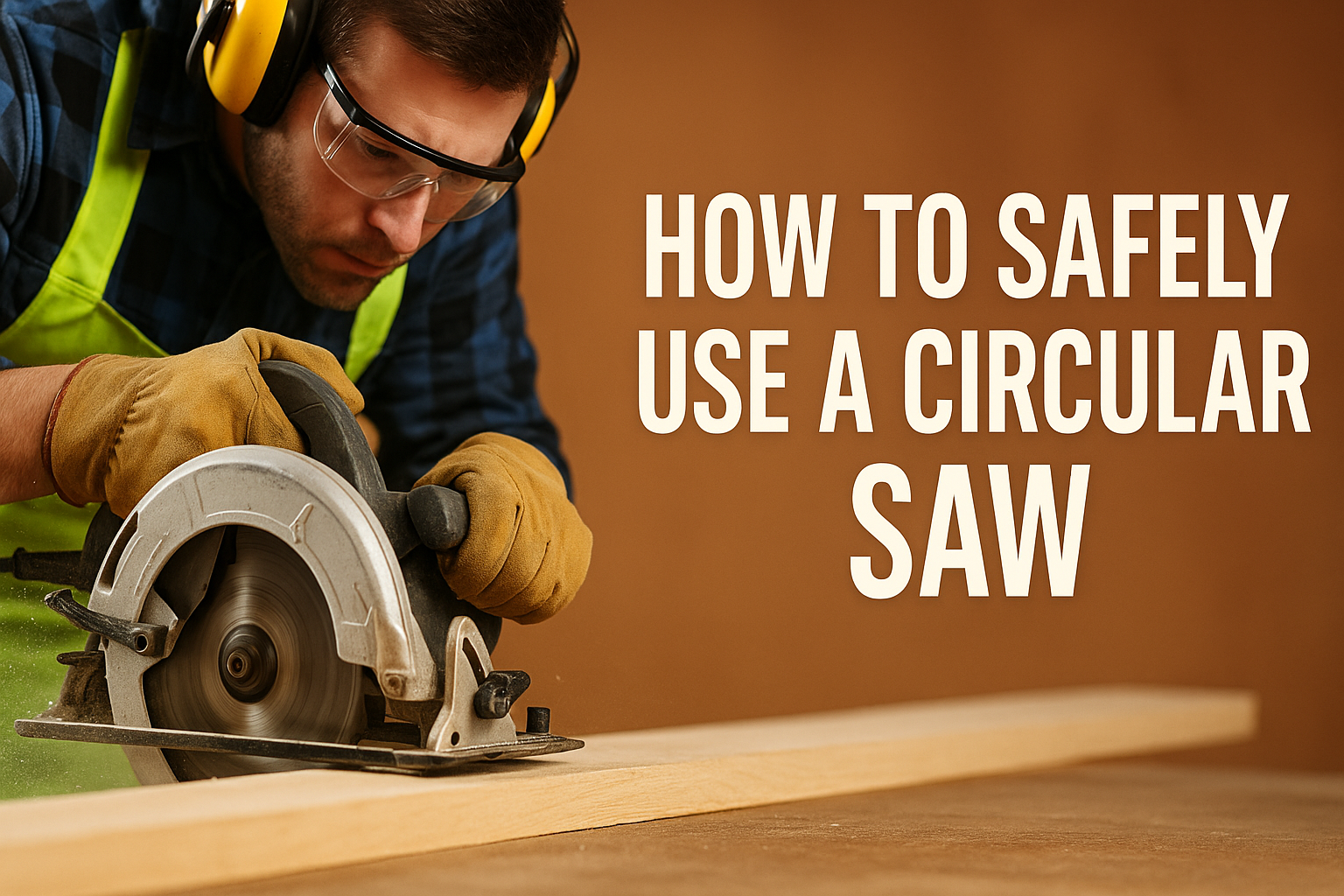If you’ve ever tackled a woodworking or home improvement project, you know that a circular saw is one of the most versatile and powerful tools in your arsenal. From cutting plywood to framing lumber, it handles tough jobs with speed and precision. But with great power comes great responsibility. Whether you’re a seasoned woodworker or a DIY enthusiast, knowing how to safely use a circular saw is essential to prevent accidents and achieve professional-quality results.
In this comprehensive guide, we’ll walk you through the safety essentials, step-by-step usage instructions, common mistakes to avoid, and pro tips for mastering the circular saw. Let’s dive in.
📌 What Is a Circular Saw?
A circular saw is a handheld power tool with a round, toothed blade that spins at high speeds. It’s used to cut wood, metal, plastic, and other materials, depending on the blade type. Circular saws can be corded (plugged into an outlet) or cordless (battery-powered).
The key components include:
- Blade guard – Covers the blade when not in use.
- Base plate/shoe – Rests on the material for stability.
- Bevel adjustment – Allows angled cuts.
- Depth adjustment – Controls how deep the blade cuts.
- Trigger switch – Powers the saw.
- Handle – Provides control and grip.
⚠️ Why Is Safety So Important with a Circular Saw?
A circular saw’s power and speed make it an indispensable tool – but also a dangerous one if mishandled. Common hazards include:
- Kickback – The saw jerks backward unexpectedly.
- Blade binding – The blade catches or stalls in the cut.
- Flying debris – Chips or fragments hit your face or eyes.
- Blade contact – Accidental contact with the blade causes severe injuries.
That’s why following proper safety protocols isn’t optional – it’s vital.
🦺 Essential Safety Gear for Using a Circular Saw
Before you even plug in your saw, make sure you’re wearing the right protective equipment:
✅ Safety glasses or goggles – To shield your eyes from flying debris.
✅ Hearing protection – Circular saws are loud, and prolonged use can damage your hearing.
✅ Dust mask – Especially when cutting treated wood or MDF, which release fine dust.
✅ Gloves – For grip and protection, though some experts recommend not wearing them to avoid snagging.
✅ Proper footwear – Closed-toe, non-slip shoes or boots to protect your feet.
📝 Step-by-Step Guide: How to Safely Use a Circular Saw
Here’s a step-by-step approach to using a circular saw safely and efficiently.
1️⃣ Read the Manual
Before your first cut, read the manufacturer’s instructions. Every saw is slightly different, and understanding its controls, features, and limitations will help you operate it safely.
2️⃣ Inspect the Saw and Blade
- Check the blade – Is it sharp, clean, and undamaged? A dull blade increases the risk of kickback and poor cuts.
- Verify the guard – Make sure the blade guard moves freely and covers the blade properly.
- Tighten everything – Ensure all screws, adjustments, and the blade are secured.
3️⃣ Adjust the Blade Depth
Set the blade to extend no more than 1/4 to 1/2 inch below the material. This minimizes kickback and helps maintain control.
4️⃣ Secure the Workpiece
- Use clamps or a sawhorse to stabilize the material.
- Never cut freehand or hold the material with your hands while cutting.
5️⃣ Mark Your Cut Line
Use a pencil and a straight edge (like a square or guide) to mark your cutting line. This helps you cut accurately and safely.
6️⃣ Check for Obstacles
Inspect the material for nails, screws, knots, or other obstructions that could damage the blade or cause kickback.
7️⃣ Maintain a Stable Stance
- Stand to the side of the cut line (not directly behind the saw) to avoid injury in case of kickback.
- Keep a firm grip on the saw with both hands.
8️⃣ Start the Saw Before Contact
- Squeeze the trigger fully to bring the blade to full speed.
- Once the blade is spinning, gently guide it into the material.
- Never force the saw; let it cut at its own pace.
9️⃣ Follow the Line
- Keep the saw shoe flat on the material.
- Use your dominant hand to guide the saw, and your other hand to stabilize.
🔟 Finish the Cut
- Release the trigger and allow the blade to come to a complete stop before lifting the saw.
- Watch for blade binding near the end of the cut – this is when the saw might catch.
🚫 Common Mistakes to Avoid with a Circular Saw
Here are some typical errors that can lead to accidents:
❌ Forcing the saw – Let the blade do the work. Forcing it increases binding and kickback risk.
❌ Lifting the saw mid-cut – Always complete the cut fully before lifting.
❌ Improper blade depth – Too deep increases kickback; too shallow might not cut cleanly.
❌ Neglecting the guard – Never disable or tie back the blade guard.
❌ Cutting without securing the workpiece – It can shift or pinch the blade, causing kickback.
❌ Standing directly behind the saw – Always stand to the side for safety.
💡 Pro Tips for Safe Circular Saw Use
🔹 Use a guide – A straight edge or guide rail ensures straight cuts and reduces wandering.
🔹 Practice on scrap material – Before starting your actual project, practice on scrap wood to get comfortable.
🔹 Mind the cord – If you’re using a corded saw, keep the cord clear of the cutting path.
🔹 Keep the workspace clean – Avoid tripping over tools, wood pieces, or extension cords.
🔹 Stay focused – Never use a circular saw if you’re tired, distracted, or under the influence of substances.
🔧 Circular Saw Maintenance for Safety
A well-maintained circular saw is a safer saw. Follow these maintenance tips:
- Clean the saw regularly – Dust and debris can interfere with performance.
- Inspect the blade – Replace dull or damaged blades immediately.
- Check the guard and adjustments – Make sure everything moves freely and locks securely.
- Lubricate moving parts – If recommended by the manufacturer, apply light oil.
🏆 Bonus: Advanced Safety Techniques
Once you’re comfortable with basic use, you can level up your safety with these advanced tips:
🔸 Ripping long boards – Use a rip guide or track system for stability.
🔸 Bevel cuts – Adjust the bevel and practice on scrap to master angled cuts.
🔸 Plunge cuts – Only attempt plunge cuts if your saw is designed for them, and practice first.
🔸 Using cordless models – Keep batteries charged and check for overheating during long sessions.
🛠️ Conclusion: Master Safety, Master the Circular Saw
A circular saw is an amazing tool that can elevate your DIY or professional projects. But it’s only as safe as your habits allow. By following this comprehensive guide, you’ll not only avoid accidents but also achieve cleaner cuts, more confidence, and better results.
So, gear up with safety equipment, follow the correct steps, and treat the circular saw with respect. Practice, stay focused, and soon you’ll be cutting like a pro.

